Dissertation: Credit Management and Bad Debts in UAE Commercial Banks
VerifiedAdded on 2023/06/08
|27
|10658
|201
Thesis and Dissertation
AI Summary
This dissertation investigates credit management practices and the challenges of bad debts within the commercial banking sector of the United Arab Emirates (UAE), with a specific focus on Abu Dhabi Commercial Bank. The study aims to evaluate the concept of credit management, analyze the issues of non-performing loans (NPLs), and assess the effectiveness of risk management policies and tools employed by banks to mitigate various types of financial risks. The research employs a qualitative methodology, utilizing secondary data from various sources such as books and journals, and applies an interpretivism philosophy with an inductive research approach. The dissertation explores the significance of credit management and its impact on the liquidity and profitability of commercial banks, while also examining the risks associated with bad debts and the importance of effective risk management strategies. The findings offer insights for financial professionals, researchers, and stakeholders in the banking sector, aiming to contribute to the reduction of financial risks and improvement of overall performance.
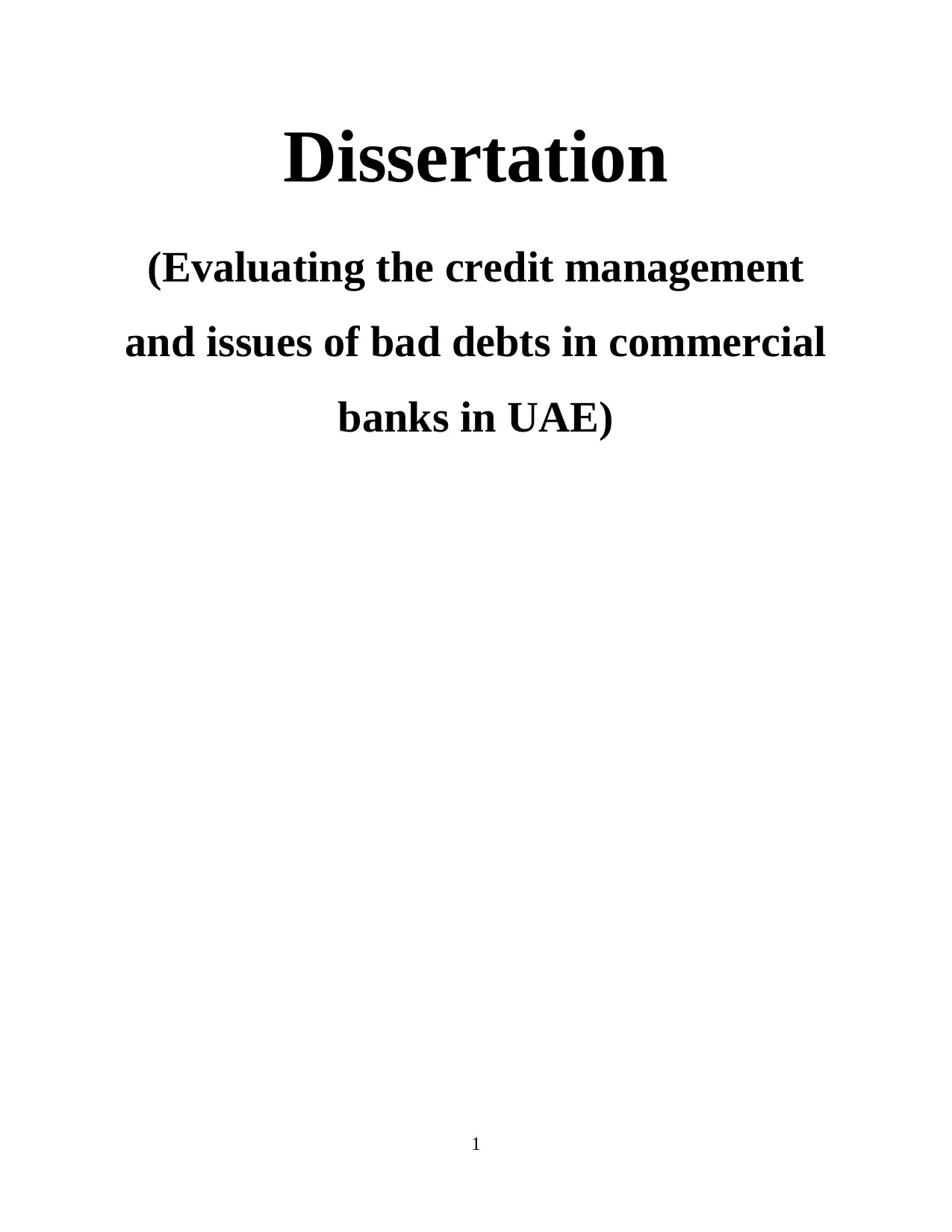
Dissertation
(Evaluating the credit management
and issues of bad debts in commercial
banks in UAE)
1
(Evaluating the credit management
and issues of bad debts in commercial
banks in UAE)
1
Paraphrase This Document
Need a fresh take? Get an instant paraphrase of this document with our AI Paraphraser
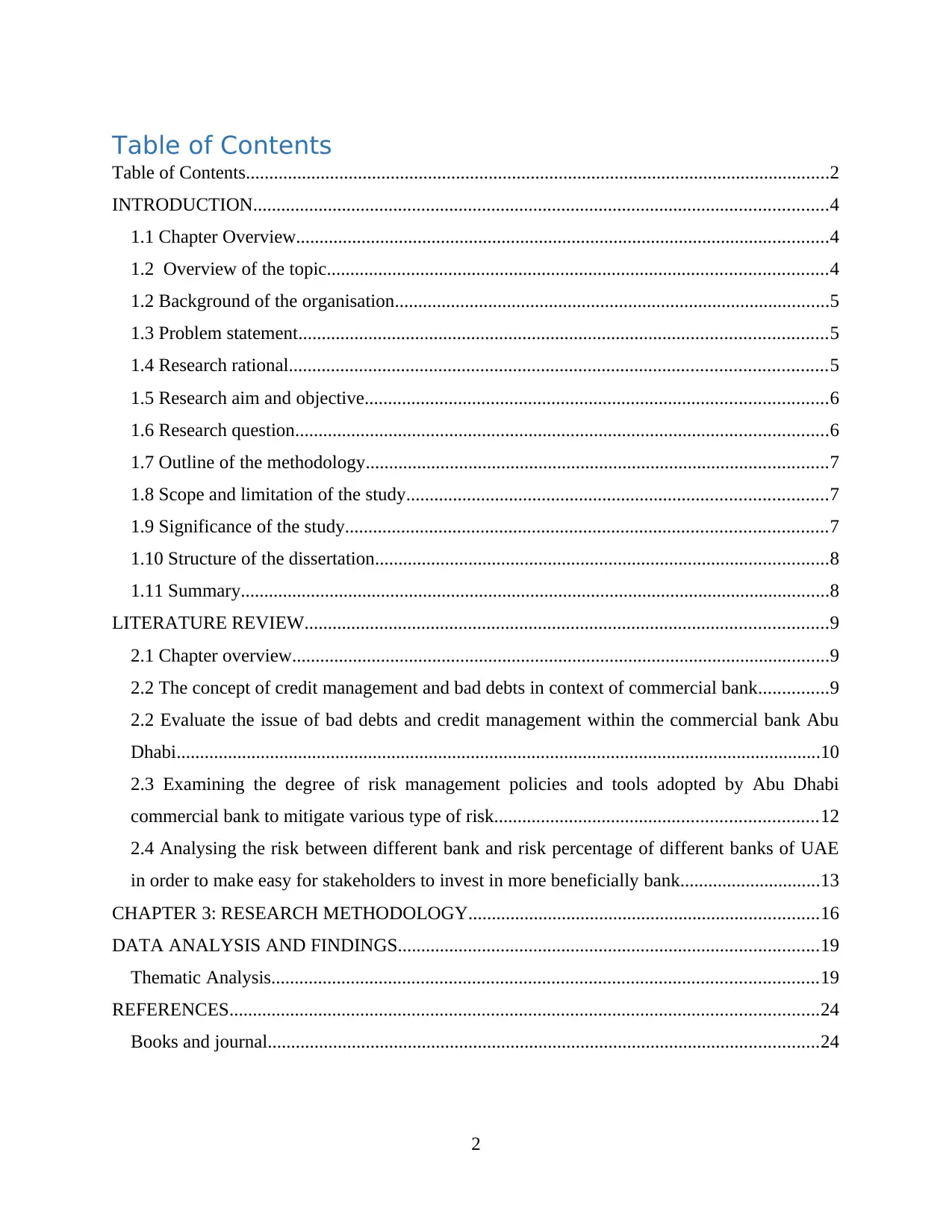
Table of Contents
Table of Contents.............................................................................................................................2
INTRODUCTION...........................................................................................................................4
1.1 Chapter Overview..................................................................................................................4
1.2 Overview of the topic...........................................................................................................4
1.2 Background of the organisation.............................................................................................5
1.3 Problem statement.................................................................................................................5
1.4 Research rational...................................................................................................................5
1.5 Research aim and objective...................................................................................................6
1.6 Research question..................................................................................................................6
1.7 Outline of the methodology...................................................................................................7
1.8 Scope and limitation of the study..........................................................................................7
1.9 Significance of the study.......................................................................................................7
1.10 Structure of the dissertation.................................................................................................8
1.11 Summary..............................................................................................................................8
LITERATURE REVIEW................................................................................................................9
2.1 Chapter overview...................................................................................................................9
2.2 The concept of credit management and bad debts in context of commercial bank...............9
2.2 Evaluate the issue of bad debts and credit management within the commercial bank Abu
Dhabi..........................................................................................................................................10
2.3 Examining the degree of risk management policies and tools adopted by Abu Dhabi
commercial bank to mitigate various type of risk.....................................................................12
2.4 Analysing the risk between different bank and risk percentage of different banks of UAE
in order to make easy for stakeholders to invest in more beneficially bank..............................13
CHAPTER 3: RESEARCH METHODOLOGY...........................................................................16
DATA ANALYSIS AND FINDINGS..........................................................................................19
Thematic Analysis.....................................................................................................................19
REFERENCES..............................................................................................................................24
Books and journal......................................................................................................................24
2
Table of Contents.............................................................................................................................2
INTRODUCTION...........................................................................................................................4
1.1 Chapter Overview..................................................................................................................4
1.2 Overview of the topic...........................................................................................................4
1.2 Background of the organisation.............................................................................................5
1.3 Problem statement.................................................................................................................5
1.4 Research rational...................................................................................................................5
1.5 Research aim and objective...................................................................................................6
1.6 Research question..................................................................................................................6
1.7 Outline of the methodology...................................................................................................7
1.8 Scope and limitation of the study..........................................................................................7
1.9 Significance of the study.......................................................................................................7
1.10 Structure of the dissertation.................................................................................................8
1.11 Summary..............................................................................................................................8
LITERATURE REVIEW................................................................................................................9
2.1 Chapter overview...................................................................................................................9
2.2 The concept of credit management and bad debts in context of commercial bank...............9
2.2 Evaluate the issue of bad debts and credit management within the commercial bank Abu
Dhabi..........................................................................................................................................10
2.3 Examining the degree of risk management policies and tools adopted by Abu Dhabi
commercial bank to mitigate various type of risk.....................................................................12
2.4 Analysing the risk between different bank and risk percentage of different banks of UAE
in order to make easy for stakeholders to invest in more beneficially bank..............................13
CHAPTER 3: RESEARCH METHODOLOGY...........................................................................16
DATA ANALYSIS AND FINDINGS..........................................................................................19
Thematic Analysis.....................................................................................................................19
REFERENCES..............................................................................................................................24
Books and journal......................................................................................................................24
2

3
⊘ This is a preview!⊘
Do you want full access?
Subscribe today to unlock all pages.

Trusted by 1+ million students worldwide
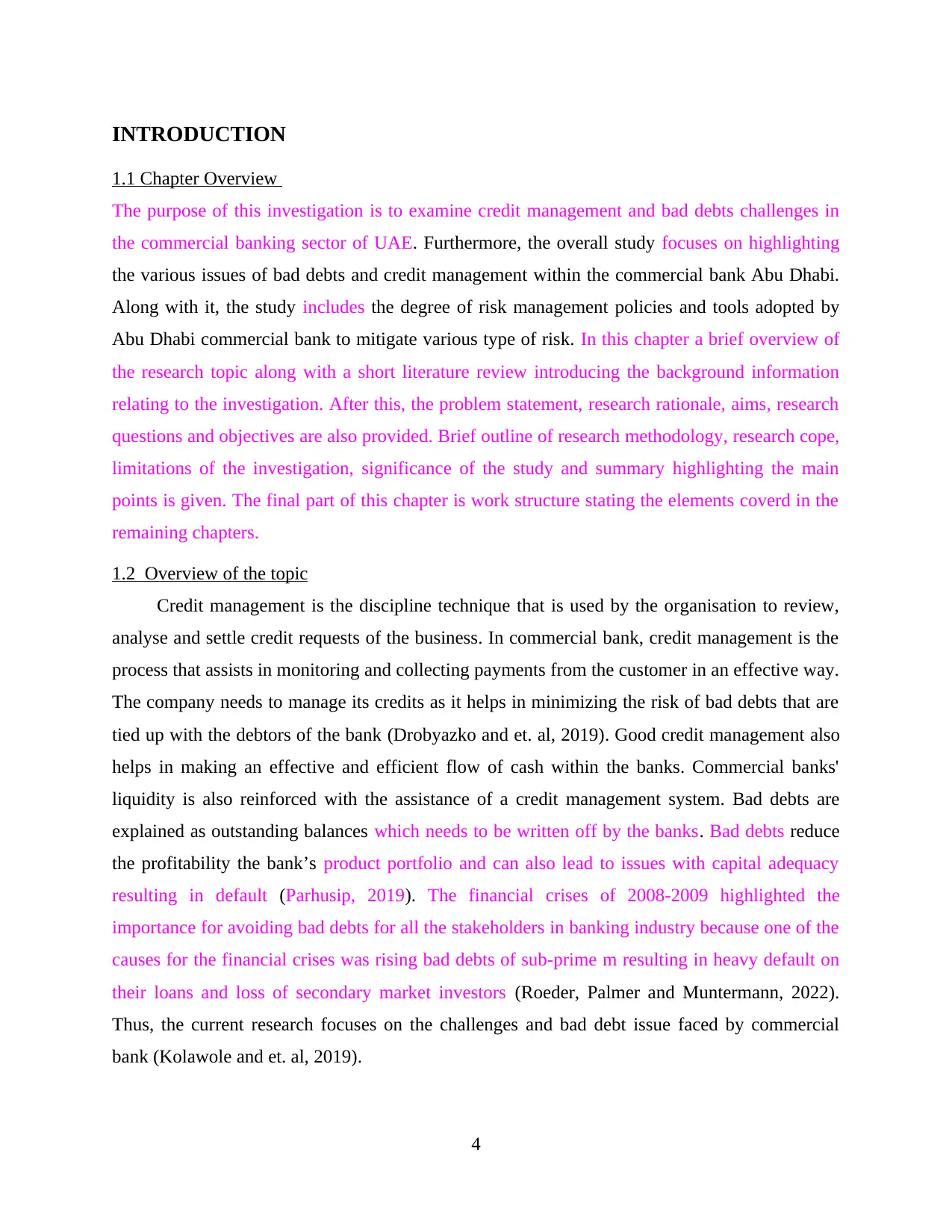
INTRODUCTION
1.1 Chapter Overview
The purpose of this investigation is to examine credit management and bad debts challenges in
the commercial banking sector of UAE. Furthermore, the overall study focuses on highlighting
the various issues of bad debts and credit management within the commercial bank Abu Dhabi.
Along with it, the study includes the degree of risk management policies and tools adopted by
Abu Dhabi commercial bank to mitigate various type of risk. In this chapter a brief overview of
the research topic along with a short literature review introducing the background information
relating to the investigation. After this, the problem statement, research rationale, aims, research
questions and objectives are also provided. Brief outline of research methodology, research cope,
limitations of the investigation, significance of the study and summary highlighting the main
points is given. The final part of this chapter is work structure stating the elements coverd in the
remaining chapters.
1.2 Overview of the topic
Credit management is the discipline technique that is used by the organisation to review,
analyse and settle credit requests of the business. In commercial bank, credit management is the
process that assists in monitoring and collecting payments from the customer in an effective way.
The company needs to manage its credits as it helps in minimizing the risk of bad debts that are
tied up with the debtors of the bank (Drobyazko and et. al, 2019). Good credit management also
helps in making an effective and efficient flow of cash within the banks. Commercial banks'
liquidity is also reinforced with the assistance of a credit management system. Bad debts are
explained as outstanding balances which needs to be written off by the banks. Bad debts reduce
the profitability the bank’s product portfolio and can also lead to issues with capital adequacy
resulting in default (Parhusip, 2019). The financial crises of 2008-2009 highlighted the
importance for avoiding bad debts for all the stakeholders in banking industry because one of the
causes for the financial crises was rising bad debts of sub-prime m resulting in heavy default on
their loans and loss of secondary market investors (Roeder, Palmer and Muntermann, 2022).
Thus, the current research focuses on the challenges and bad debt issue faced by commercial
bank (Kolawole and et. al, 2019).
4
1.1 Chapter Overview
The purpose of this investigation is to examine credit management and bad debts challenges in
the commercial banking sector of UAE. Furthermore, the overall study focuses on highlighting
the various issues of bad debts and credit management within the commercial bank Abu Dhabi.
Along with it, the study includes the degree of risk management policies and tools adopted by
Abu Dhabi commercial bank to mitigate various type of risk. In this chapter a brief overview of
the research topic along with a short literature review introducing the background information
relating to the investigation. After this, the problem statement, research rationale, aims, research
questions and objectives are also provided. Brief outline of research methodology, research cope,
limitations of the investigation, significance of the study and summary highlighting the main
points is given. The final part of this chapter is work structure stating the elements coverd in the
remaining chapters.
1.2 Overview of the topic
Credit management is the discipline technique that is used by the organisation to review,
analyse and settle credit requests of the business. In commercial bank, credit management is the
process that assists in monitoring and collecting payments from the customer in an effective way.
The company needs to manage its credits as it helps in minimizing the risk of bad debts that are
tied up with the debtors of the bank (Drobyazko and et. al, 2019). Good credit management also
helps in making an effective and efficient flow of cash within the banks. Commercial banks'
liquidity is also reinforced with the assistance of a credit management system. Bad debts are
explained as outstanding balances which needs to be written off by the banks. Bad debts reduce
the profitability the bank’s product portfolio and can also lead to issues with capital adequacy
resulting in default (Parhusip, 2019). The financial crises of 2008-2009 highlighted the
importance for avoiding bad debts for all the stakeholders in banking industry because one of the
causes for the financial crises was rising bad debts of sub-prime m resulting in heavy default on
their loans and loss of secondary market investors (Roeder, Palmer and Muntermann, 2022).
Thus, the current research focuses on the challenges and bad debt issue faced by commercial
bank (Kolawole and et. al, 2019).
4
Paraphrase This Document
Need a fresh take? Get an instant paraphrase of this document with our AI Paraphraser
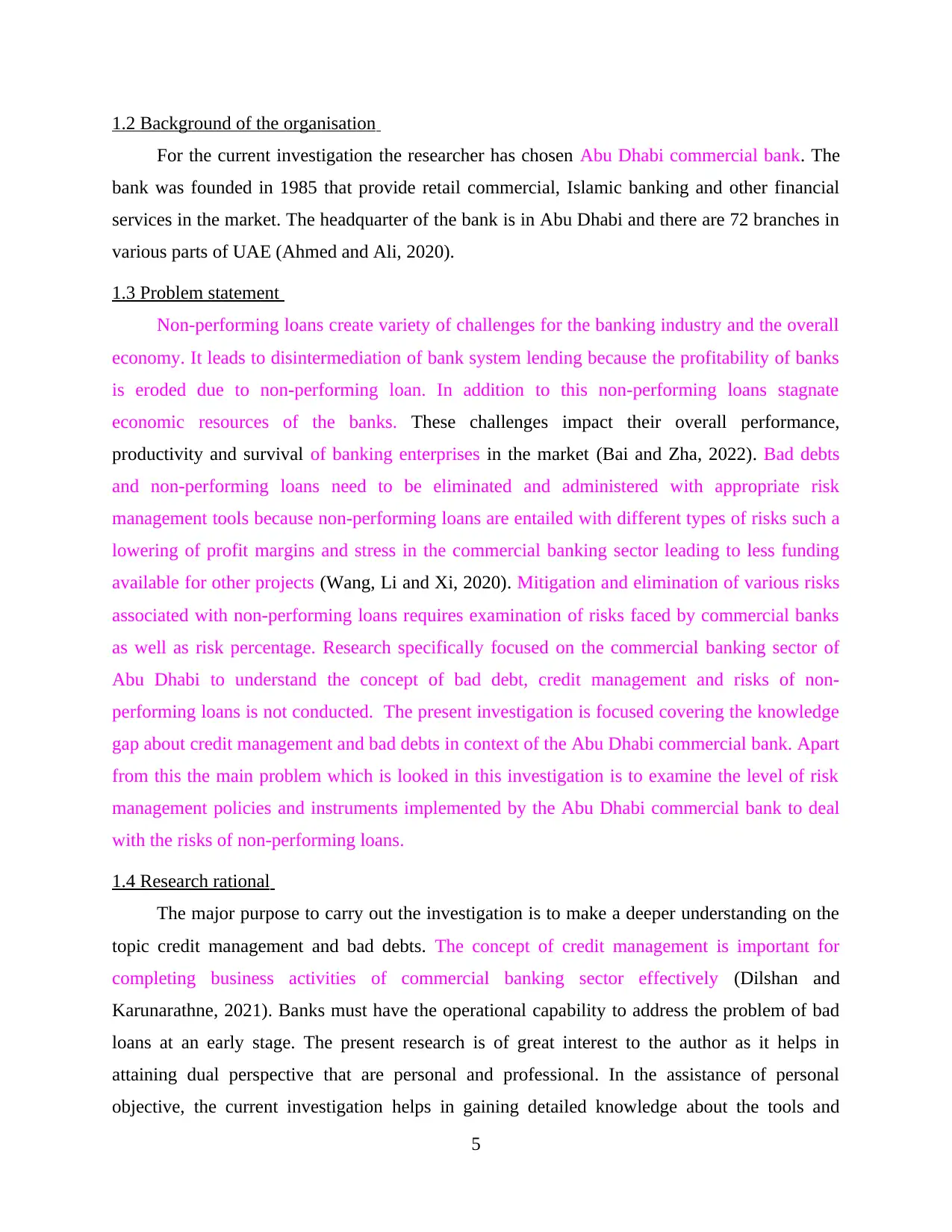
1.2 Background of the organisation
For the current investigation the researcher has chosen Abu Dhabi commercial bank. The
bank was founded in 1985 that provide retail commercial, Islamic banking and other financial
services in the market. The headquarter of the bank is in Abu Dhabi and there are 72 branches in
various parts of UAE (Ahmed and Ali, 2020).
1.3 Problem statement
Non-performing loans create variety of challenges for the banking industry and the overall
economy. It leads to disintermediation of bank system lending because the profitability of banks
is eroded due to non-performing loan. In addition to this non-performing loans stagnate
economic resources of the banks. These challenges impact their overall performance,
productivity and survival of banking enterprises in the market (Bai and Zha, 2022). Bad debts
and non-performing loans need to be eliminated and administered with appropriate risk
management tools because non-performing loans are entailed with different types of risks such a
lowering of profit margins and stress in the commercial banking sector leading to less funding
available for other projects (Wang, Li and Xi, 2020). Mitigation and elimination of various risks
associated with non-performing loans requires examination of risks faced by commercial banks
as well as risk percentage. Research specifically focused on the commercial banking sector of
Abu Dhabi to understand the concept of bad debt, credit management and risks of non-
performing loans is not conducted. The present investigation is focused covering the knowledge
gap about credit management and bad debts in context of the Abu Dhabi commercial bank. Apart
from this the main problem which is looked in this investigation is to examine the level of risk
management policies and instruments implemented by the Abu Dhabi commercial bank to deal
with the risks of non-performing loans.
1.4 Research rational
The major purpose to carry out the investigation is to make a deeper understanding on the
topic credit management and bad debts. The concept of credit management is important for
completing business activities of commercial banking sector effectively (Dilshan and
Karunarathne, 2021). Banks must have the operational capability to address the problem of bad
loans at an early stage. The present research is of great interest to the author as it helps in
attaining dual perspective that are personal and professional. In the assistance of personal
objective, the current investigation helps in gaining detailed knowledge about the tools and
5
For the current investigation the researcher has chosen Abu Dhabi commercial bank. The
bank was founded in 1985 that provide retail commercial, Islamic banking and other financial
services in the market. The headquarter of the bank is in Abu Dhabi and there are 72 branches in
various parts of UAE (Ahmed and Ali, 2020).
1.3 Problem statement
Non-performing loans create variety of challenges for the banking industry and the overall
economy. It leads to disintermediation of bank system lending because the profitability of banks
is eroded due to non-performing loan. In addition to this non-performing loans stagnate
economic resources of the banks. These challenges impact their overall performance,
productivity and survival of banking enterprises in the market (Bai and Zha, 2022). Bad debts
and non-performing loans need to be eliminated and administered with appropriate risk
management tools because non-performing loans are entailed with different types of risks such a
lowering of profit margins and stress in the commercial banking sector leading to less funding
available for other projects (Wang, Li and Xi, 2020). Mitigation and elimination of various risks
associated with non-performing loans requires examination of risks faced by commercial banks
as well as risk percentage. Research specifically focused on the commercial banking sector of
Abu Dhabi to understand the concept of bad debt, credit management and risks of non-
performing loans is not conducted. The present investigation is focused covering the knowledge
gap about credit management and bad debts in context of the Abu Dhabi commercial bank. Apart
from this the main problem which is looked in this investigation is to examine the level of risk
management policies and instruments implemented by the Abu Dhabi commercial bank to deal
with the risks of non-performing loans.
1.4 Research rational
The major purpose to carry out the investigation is to make a deeper understanding on the
topic credit management and bad debts. The concept of credit management is important for
completing business activities of commercial banking sector effectively (Dilshan and
Karunarathne, 2021). Banks must have the operational capability to address the problem of bad
loans at an early stage. The present research is of great interest to the author as it helps in
attaining dual perspective that are personal and professional. In the assistance of personal
objective, the current investigation helps in gaining detailed knowledge about the tools and
5
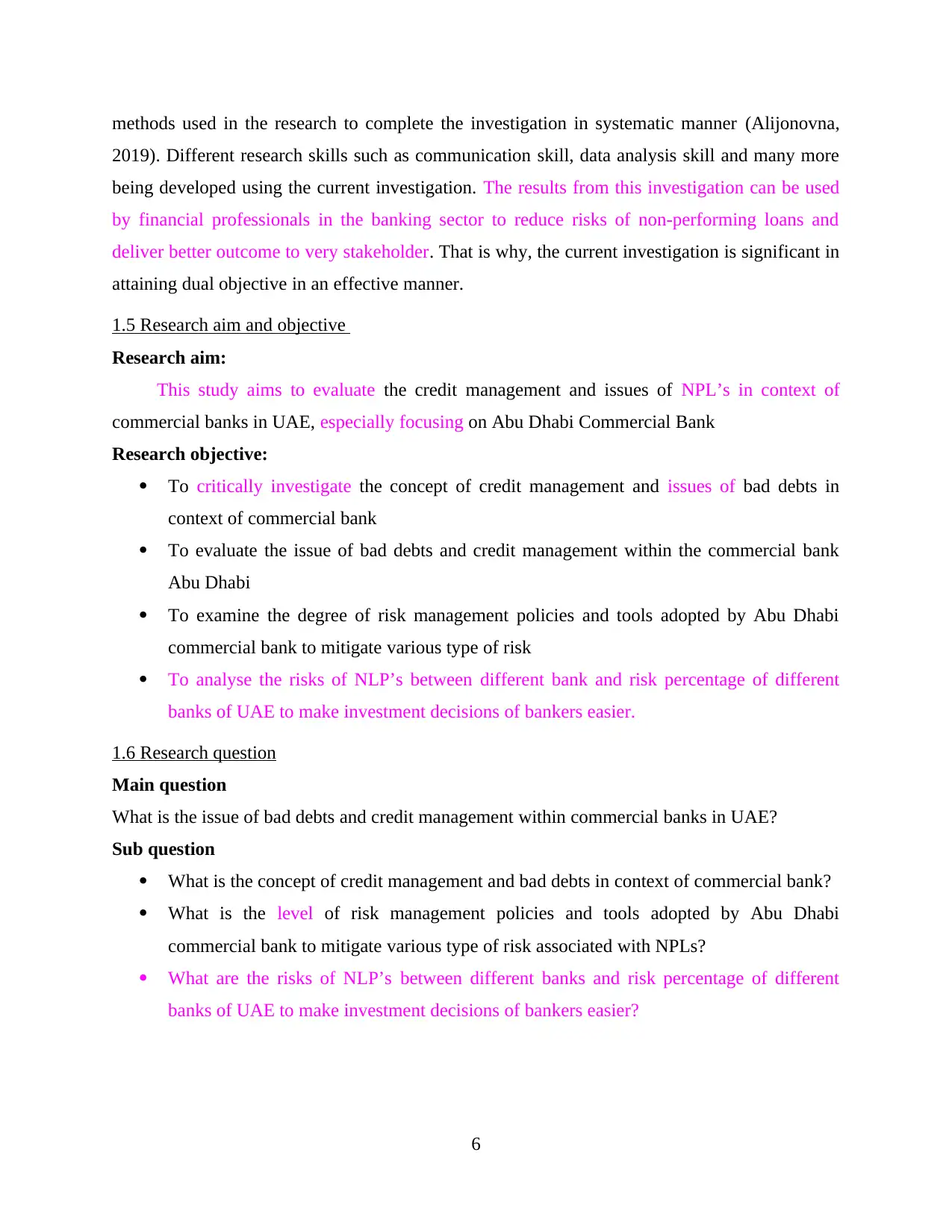
methods used in the research to complete the investigation in systematic manner (Alijonovna,
2019). Different research skills such as communication skill, data analysis skill and many more
being developed using the current investigation. The results from this investigation can be used
by financial professionals in the banking sector to reduce risks of non-performing loans and
deliver better outcome to very stakeholder. That is why, the current investigation is significant in
attaining dual objective in an effective manner.
1.5 Research aim and objective
Research aim:
This study aims to evaluate the credit management and issues of NPL’s in context of
commercial banks in UAE, especially focusing on Abu Dhabi Commercial Bank
Research objective:
To critically investigate the concept of credit management and issues of bad debts in
context of commercial bank
To evaluate the issue of bad debts and credit management within the commercial bank
Abu Dhabi
To examine the degree of risk management policies and tools adopted by Abu Dhabi
commercial bank to mitigate various type of risk
To analyse the risks of NLP’s between different bank and risk percentage of different
banks of UAE to make investment decisions of bankers easier.
1.6 Research question
Main question
What is the issue of bad debts and credit management within commercial banks in UAE?
Sub question
What is the concept of credit management and bad debts in context of commercial bank?
What is the level of risk management policies and tools adopted by Abu Dhabi
commercial bank to mitigate various type of risk associated with NPLs?
What are the risks of NLP’s between different banks and risk percentage of different
banks of UAE to make investment decisions of bankers easier?
6
2019). Different research skills such as communication skill, data analysis skill and many more
being developed using the current investigation. The results from this investigation can be used
by financial professionals in the banking sector to reduce risks of non-performing loans and
deliver better outcome to very stakeholder. That is why, the current investigation is significant in
attaining dual objective in an effective manner.
1.5 Research aim and objective
Research aim:
This study aims to evaluate the credit management and issues of NPL’s in context of
commercial banks in UAE, especially focusing on Abu Dhabi Commercial Bank
Research objective:
To critically investigate the concept of credit management and issues of bad debts in
context of commercial bank
To evaluate the issue of bad debts and credit management within the commercial bank
Abu Dhabi
To examine the degree of risk management policies and tools adopted by Abu Dhabi
commercial bank to mitigate various type of risk
To analyse the risks of NLP’s between different bank and risk percentage of different
banks of UAE to make investment decisions of bankers easier.
1.6 Research question
Main question
What is the issue of bad debts and credit management within commercial banks in UAE?
Sub question
What is the concept of credit management and bad debts in context of commercial bank?
What is the level of risk management policies and tools adopted by Abu Dhabi
commercial bank to mitigate various type of risk associated with NPLs?
What are the risks of NLP’s between different banks and risk percentage of different
banks of UAE to make investment decisions of bankers easier?
6
⊘ This is a preview!⊘
Do you want full access?
Subscribe today to unlock all pages.

Trusted by 1+ million students worldwide
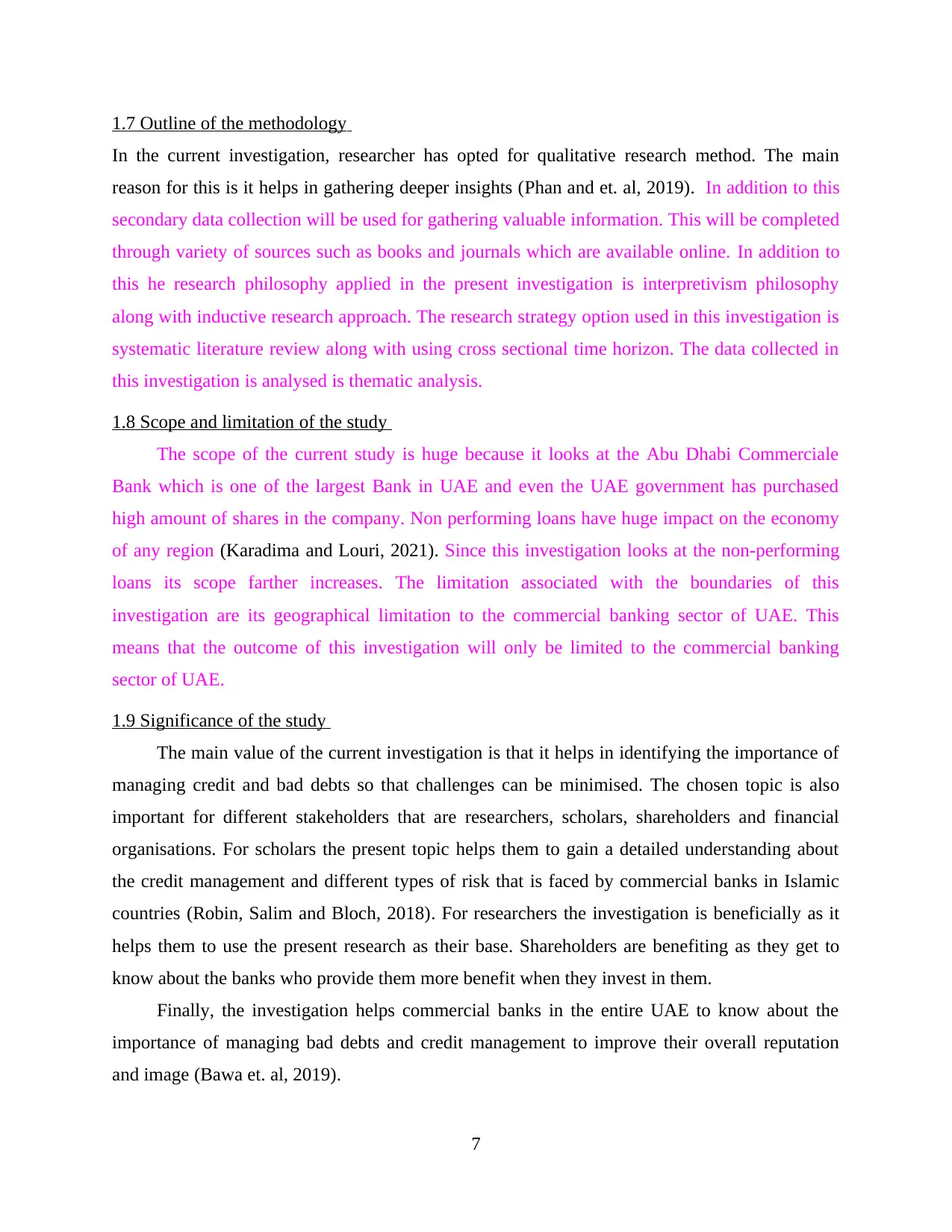
1.7 Outline of the methodology
In the current investigation, researcher has opted for qualitative research method. The main
reason for this is it helps in gathering deeper insights (Phan and et. al, 2019). In addition to this
secondary data collection will be used for gathering valuable information. This will be completed
through variety of sources such as books and journals which are available online. In addition to
this he research philosophy applied in the present investigation is interpretivism philosophy
along with inductive research approach. The research strategy option used in this investigation is
systematic literature review along with using cross sectional time horizon. The data collected in
this investigation is analysed is thematic analysis.
1.8 Scope and limitation of the study
The scope of the current study is huge because it looks at the Abu Dhabi Commerciale
Bank which is one of the largest Bank in UAE and even the UAE government has purchased
high amount of shares in the company. Non performing loans have huge impact on the economy
of any region (Karadima and Louri, 2021). Since this investigation looks at the non-performing
loans its scope farther increases. The limitation associated with the boundaries of this
investigation are its geographical limitation to the commercial banking sector of UAE. This
means that the outcome of this investigation will only be limited to the commercial banking
sector of UAE.
1.9 Significance of the study
The main value of the current investigation is that it helps in identifying the importance of
managing credit and bad debts so that challenges can be minimised. The chosen topic is also
important for different stakeholders that are researchers, scholars, shareholders and financial
organisations. For scholars the present topic helps them to gain a detailed understanding about
the credit management and different types of risk that is faced by commercial banks in Islamic
countries (Robin, Salim and Bloch, 2018). For researchers the investigation is beneficially as it
helps them to use the present research as their base. Shareholders are benefiting as they get to
know about the banks who provide them more benefit when they invest in them.
Finally, the investigation helps commercial banks in the entire UAE to know about the
importance of managing bad debts and credit management to improve their overall reputation
and image (Bawa et. al, 2019).
7
In the current investigation, researcher has opted for qualitative research method. The main
reason for this is it helps in gathering deeper insights (Phan and et. al, 2019). In addition to this
secondary data collection will be used for gathering valuable information. This will be completed
through variety of sources such as books and journals which are available online. In addition to
this he research philosophy applied in the present investigation is interpretivism philosophy
along with inductive research approach. The research strategy option used in this investigation is
systematic literature review along with using cross sectional time horizon. The data collected in
this investigation is analysed is thematic analysis.
1.8 Scope and limitation of the study
The scope of the current study is huge because it looks at the Abu Dhabi Commerciale
Bank which is one of the largest Bank in UAE and even the UAE government has purchased
high amount of shares in the company. Non performing loans have huge impact on the economy
of any region (Karadima and Louri, 2021). Since this investigation looks at the non-performing
loans its scope farther increases. The limitation associated with the boundaries of this
investigation are its geographical limitation to the commercial banking sector of UAE. This
means that the outcome of this investigation will only be limited to the commercial banking
sector of UAE.
1.9 Significance of the study
The main value of the current investigation is that it helps in identifying the importance of
managing credit and bad debts so that challenges can be minimised. The chosen topic is also
important for different stakeholders that are researchers, scholars, shareholders and financial
organisations. For scholars the present topic helps them to gain a detailed understanding about
the credit management and different types of risk that is faced by commercial banks in Islamic
countries (Robin, Salim and Bloch, 2018). For researchers the investigation is beneficially as it
helps them to use the present research as their base. Shareholders are benefiting as they get to
know about the banks who provide them more benefit when they invest in them.
Finally, the investigation helps commercial banks in the entire UAE to know about the
importance of managing bad debts and credit management to improve their overall reputation
and image (Bawa et. al, 2019).
7
Paraphrase This Document
Need a fresh take? Get an instant paraphrase of this document with our AI Paraphraser
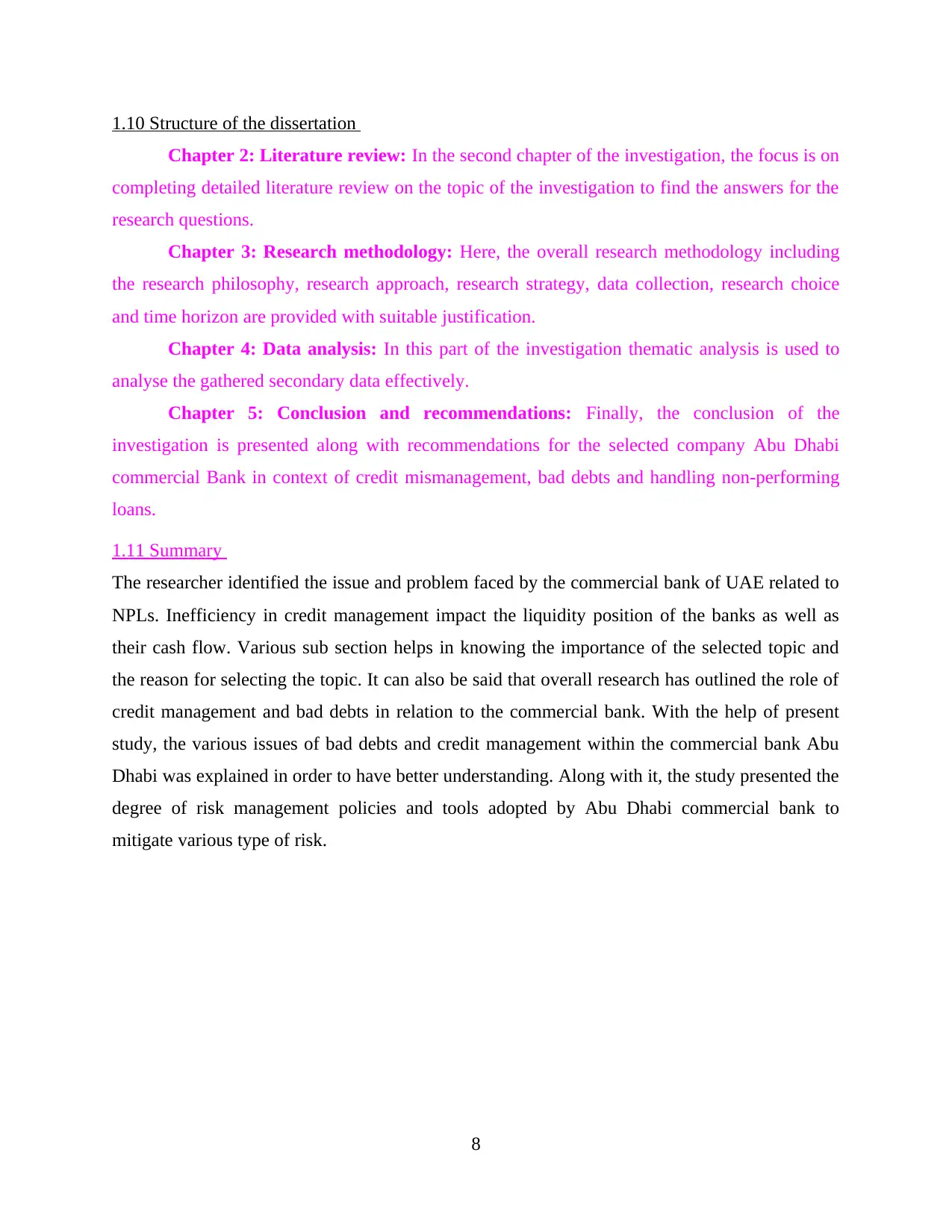
1.10 Structure of the dissertation
Chapter 2: Literature review: In the second chapter of the investigation, the focus is on
completing detailed literature review on the topic of the investigation to find the answers for the
research questions.
Chapter 3: Research methodology: Here, the overall research methodology including
the research philosophy, research approach, research strategy, data collection, research choice
and time horizon are provided with suitable justification.
Chapter 4: Data analysis: In this part of the investigation thematic analysis is used to
analyse the gathered secondary data effectively.
Chapter 5: Conclusion and recommendations: Finally, the conclusion of the
investigation is presented along with recommendations for the selected company Abu Dhabi
commercial Bank in context of credit mismanagement, bad debts and handling non-performing
loans.
1.11 Summary
The researcher identified the issue and problem faced by the commercial bank of UAE related to
NPLs. Inefficiency in credit management impact the liquidity position of the banks as well as
their cash flow. Various sub section helps in knowing the importance of the selected topic and
the reason for selecting the topic. It can also be said that overall research has outlined the role of
credit management and bad debts in relation to the commercial bank. With the help of present
study, the various issues of bad debts and credit management within the commercial bank Abu
Dhabi was explained in order to have better understanding. Along with it, the study presented the
degree of risk management policies and tools adopted by Abu Dhabi commercial bank to
mitigate various type of risk.
8
Chapter 2: Literature review: In the second chapter of the investigation, the focus is on
completing detailed literature review on the topic of the investigation to find the answers for the
research questions.
Chapter 3: Research methodology: Here, the overall research methodology including
the research philosophy, research approach, research strategy, data collection, research choice
and time horizon are provided with suitable justification.
Chapter 4: Data analysis: In this part of the investigation thematic analysis is used to
analyse the gathered secondary data effectively.
Chapter 5: Conclusion and recommendations: Finally, the conclusion of the
investigation is presented along with recommendations for the selected company Abu Dhabi
commercial Bank in context of credit mismanagement, bad debts and handling non-performing
loans.
1.11 Summary
The researcher identified the issue and problem faced by the commercial bank of UAE related to
NPLs. Inefficiency in credit management impact the liquidity position of the banks as well as
their cash flow. Various sub section helps in knowing the importance of the selected topic and
the reason for selecting the topic. It can also be said that overall research has outlined the role of
credit management and bad debts in relation to the commercial bank. With the help of present
study, the various issues of bad debts and credit management within the commercial bank Abu
Dhabi was explained in order to have better understanding. Along with it, the study presented the
degree of risk management policies and tools adopted by Abu Dhabi commercial bank to
mitigate various type of risk.
8
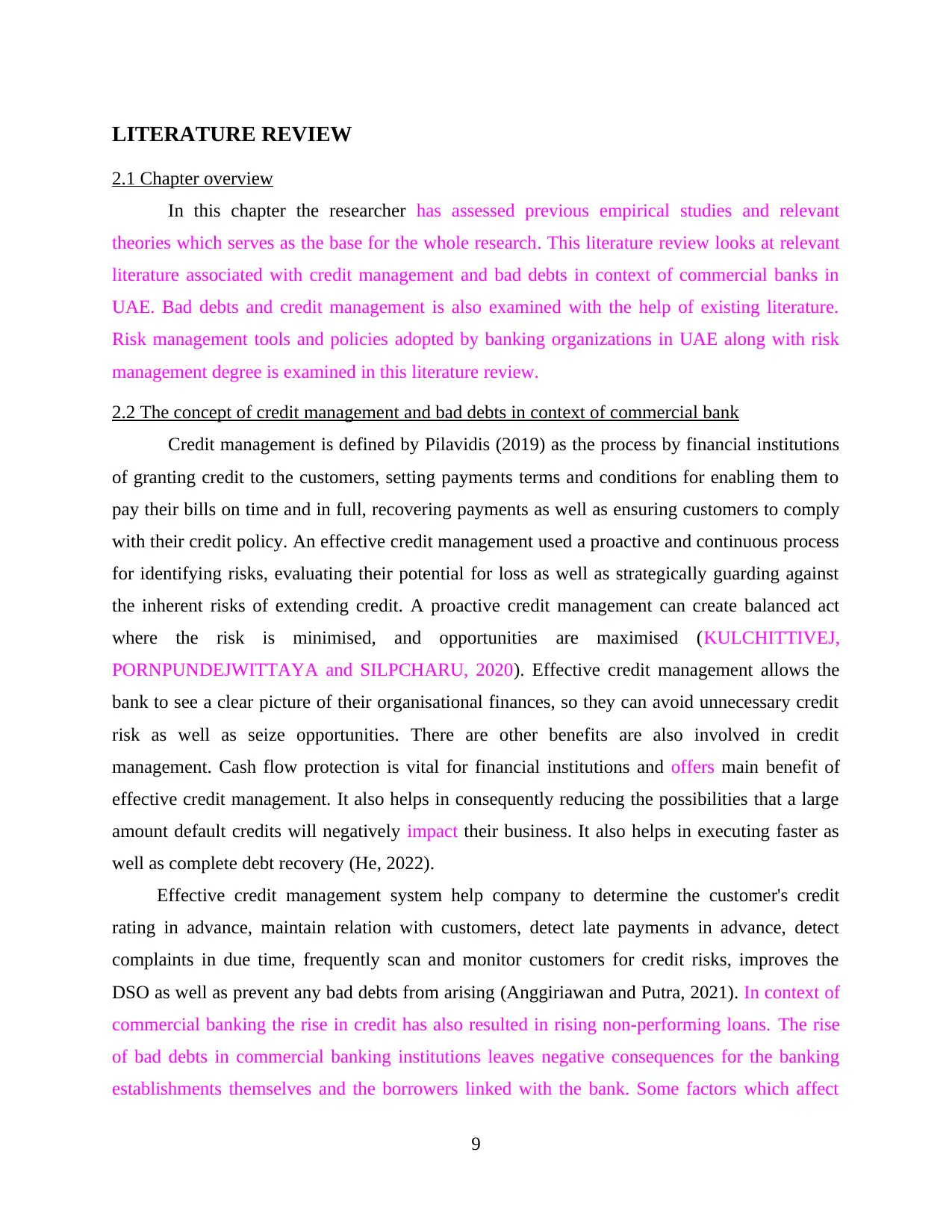
LITERATURE REVIEW
2.1 Chapter overview
In this chapter the researcher has assessed previous empirical studies and relevant
theories which serves as the base for the whole research. This literature review looks at relevant
literature associated with credit management and bad debts in context of commercial banks in
UAE. Bad debts and credit management is also examined with the help of existing literature.
Risk management tools and policies adopted by banking organizations in UAE along with risk
management degree is examined in this literature review.
2.2 The concept of credit management and bad debts in context of commercial bank
Credit management is defined by Pilavidis (2019) as the process by financial institutions
of granting credit to the customers, setting payments terms and conditions for enabling them to
pay their bills on time and in full, recovering payments as well as ensuring customers to comply
with their credit policy. An effective credit management used a proactive and continuous process
for identifying risks, evaluating their potential for loss as well as strategically guarding against
the inherent risks of extending credit. A proactive credit management can create balanced act
where the risk is minimised, and opportunities are maximised (KULCHITTIVEJ,
PORNPUNDEJWITTAYA and SILPCHARU, 2020). Effective credit management allows the
bank to see a clear picture of their organisational finances, so they can avoid unnecessary credit
risk as well as seize opportunities. There are other benefits are also involved in credit
management. Cash flow protection is vital for financial institutions and offers main benefit of
effective credit management. It also helps in consequently reducing the possibilities that a large
amount default credits will negatively impact their business. It also helps in executing faster as
well as complete debt recovery (He, 2022).
Effective credit management system help company to determine the customer's credit
rating in advance, maintain relation with customers, detect late payments in advance, detect
complaints in due time, frequently scan and monitor customers for credit risks, improves the
DSO as well as prevent any bad debts from arising (Anggiriawan and Putra, 2021). In context of
commercial banking the rise in credit has also resulted in rising non-performing loans. The rise
of bad debts in commercial banking institutions leaves negative consequences for the banking
establishments themselves and the borrowers linked with the bank. Some factors which affect
9
2.1 Chapter overview
In this chapter the researcher has assessed previous empirical studies and relevant
theories which serves as the base for the whole research. This literature review looks at relevant
literature associated with credit management and bad debts in context of commercial banks in
UAE. Bad debts and credit management is also examined with the help of existing literature.
Risk management tools and policies adopted by banking organizations in UAE along with risk
management degree is examined in this literature review.
2.2 The concept of credit management and bad debts in context of commercial bank
Credit management is defined by Pilavidis (2019) as the process by financial institutions
of granting credit to the customers, setting payments terms and conditions for enabling them to
pay their bills on time and in full, recovering payments as well as ensuring customers to comply
with their credit policy. An effective credit management used a proactive and continuous process
for identifying risks, evaluating their potential for loss as well as strategically guarding against
the inherent risks of extending credit. A proactive credit management can create balanced act
where the risk is minimised, and opportunities are maximised (KULCHITTIVEJ,
PORNPUNDEJWITTAYA and SILPCHARU, 2020). Effective credit management allows the
bank to see a clear picture of their organisational finances, so they can avoid unnecessary credit
risk as well as seize opportunities. There are other benefits are also involved in credit
management. Cash flow protection is vital for financial institutions and offers main benefit of
effective credit management. It also helps in consequently reducing the possibilities that a large
amount default credits will negatively impact their business. It also helps in executing faster as
well as complete debt recovery (He, 2022).
Effective credit management system help company to determine the customer's credit
rating in advance, maintain relation with customers, detect late payments in advance, detect
complaints in due time, frequently scan and monitor customers for credit risks, improves the
DSO as well as prevent any bad debts from arising (Anggiriawan and Putra, 2021). In context of
commercial banking the rise in credit has also resulted in rising non-performing loans. The rise
of bad debts in commercial banking institutions leaves negative consequences for the banking
establishments themselves and the borrowers linked with the bank. Some factors which affect
9
⊘ This is a preview!⊘
Do you want full access?
Subscribe today to unlock all pages.

Trusted by 1+ million students worldwide
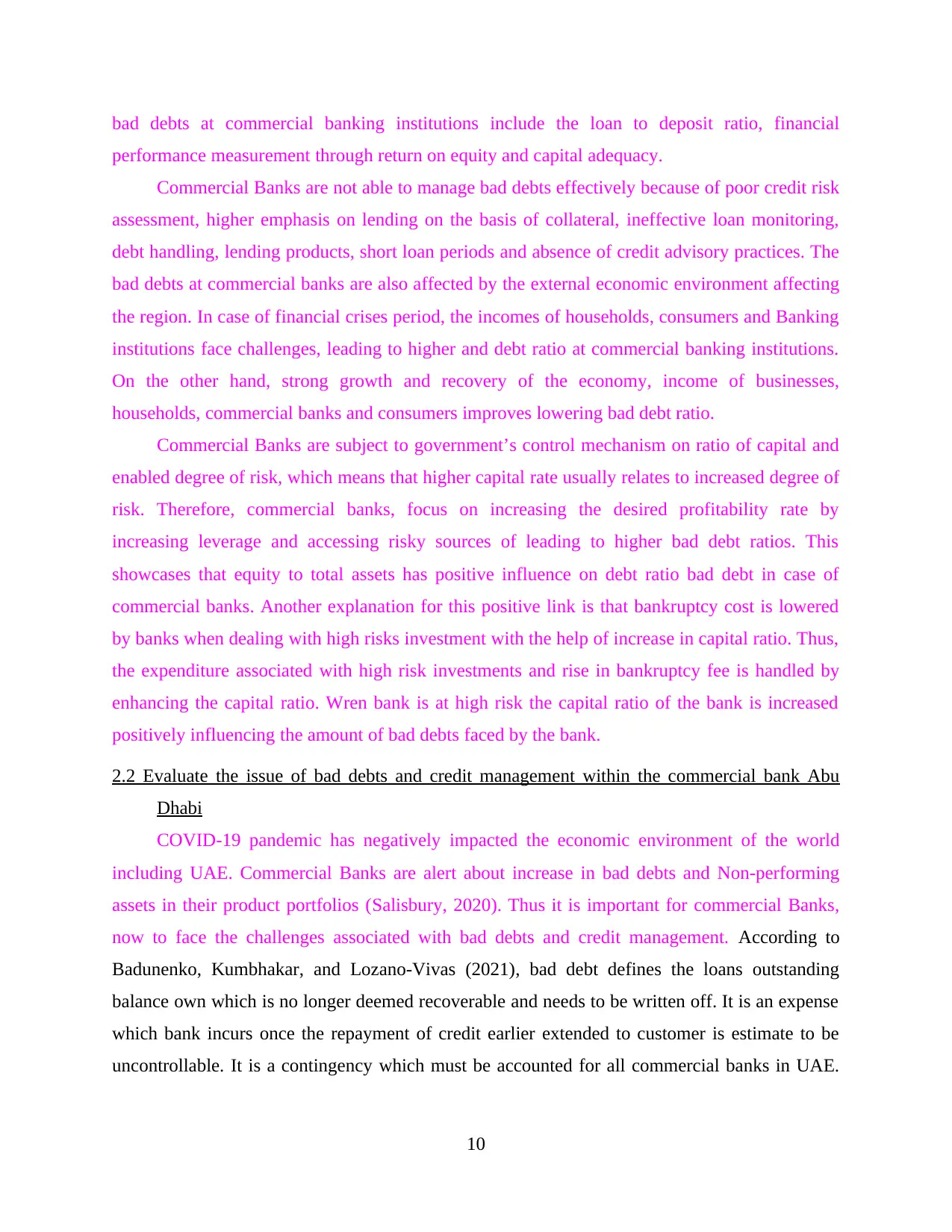
bad debts at commercial banking institutions include the loan to deposit ratio, financial
performance measurement through return on equity and capital adequacy.
Commercial Banks are not able to manage bad debts effectively because of poor credit risk
assessment, higher emphasis on lending on the basis of collateral, ineffective loan monitoring,
debt handling, lending products, short loan periods and absence of credit advisory practices. The
bad debts at commercial banks are also affected by the external economic environment affecting
the region. In case of financial crises period, the incomes of households, consumers and Banking
institutions face challenges, leading to higher and debt ratio at commercial banking institutions.
On the other hand, strong growth and recovery of the economy, income of businesses,
households, commercial banks and consumers improves lowering bad debt ratio.
Commercial Banks are subject to government’s control mechanism on ratio of capital and
enabled degree of risk, which means that higher capital rate usually relates to increased degree of
risk. Therefore, commercial banks, focus on increasing the desired profitability rate by
increasing leverage and accessing risky sources of leading to higher bad debt ratios. This
showcases that equity to total assets has positive influence on debt ratio bad debt in case of
commercial banks. Another explanation for this positive link is that bankruptcy cost is lowered
by banks when dealing with high risks investment with the help of increase in capital ratio. Thus,
the expenditure associated with high risk investments and rise in bankruptcy fee is handled by
enhancing the capital ratio. Wren bank is at high risk the capital ratio of the bank is increased
positively influencing the amount of bad debts faced by the bank.
2.2 Evaluate the issue of bad debts and credit management within the commercial bank Abu
Dhabi
COVID-19 pandemic has negatively impacted the economic environment of the world
including UAE. Commercial Banks are alert about increase in bad debts and Non-performing
assets in their product portfolios (Salisbury, 2020). Thus it is important for commercial Banks,
now to face the challenges associated with bad debts and credit management. According to
Badunenko, Kumbhakar, and Lozano‐Vivas (2021), bad debt defines the loans outstanding
balance own which is no longer deemed recoverable and needs to be written off. It is an expense
which bank incurs once the repayment of credit earlier extended to customer is estimate to be
uncontrollable. It is a contingency which must be accounted for all commercial banks in UAE.
10
performance measurement through return on equity and capital adequacy.
Commercial Banks are not able to manage bad debts effectively because of poor credit risk
assessment, higher emphasis on lending on the basis of collateral, ineffective loan monitoring,
debt handling, lending products, short loan periods and absence of credit advisory practices. The
bad debts at commercial banks are also affected by the external economic environment affecting
the region. In case of financial crises period, the incomes of households, consumers and Banking
institutions face challenges, leading to higher and debt ratio at commercial banking institutions.
On the other hand, strong growth and recovery of the economy, income of businesses,
households, commercial banks and consumers improves lowering bad debt ratio.
Commercial Banks are subject to government’s control mechanism on ratio of capital and
enabled degree of risk, which means that higher capital rate usually relates to increased degree of
risk. Therefore, commercial banks, focus on increasing the desired profitability rate by
increasing leverage and accessing risky sources of leading to higher bad debt ratios. This
showcases that equity to total assets has positive influence on debt ratio bad debt in case of
commercial banks. Another explanation for this positive link is that bankruptcy cost is lowered
by banks when dealing with high risks investment with the help of increase in capital ratio. Thus,
the expenditure associated with high risk investments and rise in bankruptcy fee is handled by
enhancing the capital ratio. Wren bank is at high risk the capital ratio of the bank is increased
positively influencing the amount of bad debts faced by the bank.
2.2 Evaluate the issue of bad debts and credit management within the commercial bank Abu
Dhabi
COVID-19 pandemic has negatively impacted the economic environment of the world
including UAE. Commercial Banks are alert about increase in bad debts and Non-performing
assets in their product portfolios (Salisbury, 2020). Thus it is important for commercial Banks,
now to face the challenges associated with bad debts and credit management. According to
Badunenko, Kumbhakar, and Lozano‐Vivas (2021), bad debt defines the loans outstanding
balance own which is no longer deemed recoverable and needs to be written off. It is an expense
which bank incurs once the repayment of credit earlier extended to customer is estimate to be
uncontrollable. It is a contingency which must be accounted for all commercial banks in UAE.
10
Paraphrase This Document
Need a fresh take? Get an instant paraphrase of this document with our AI Paraphraser
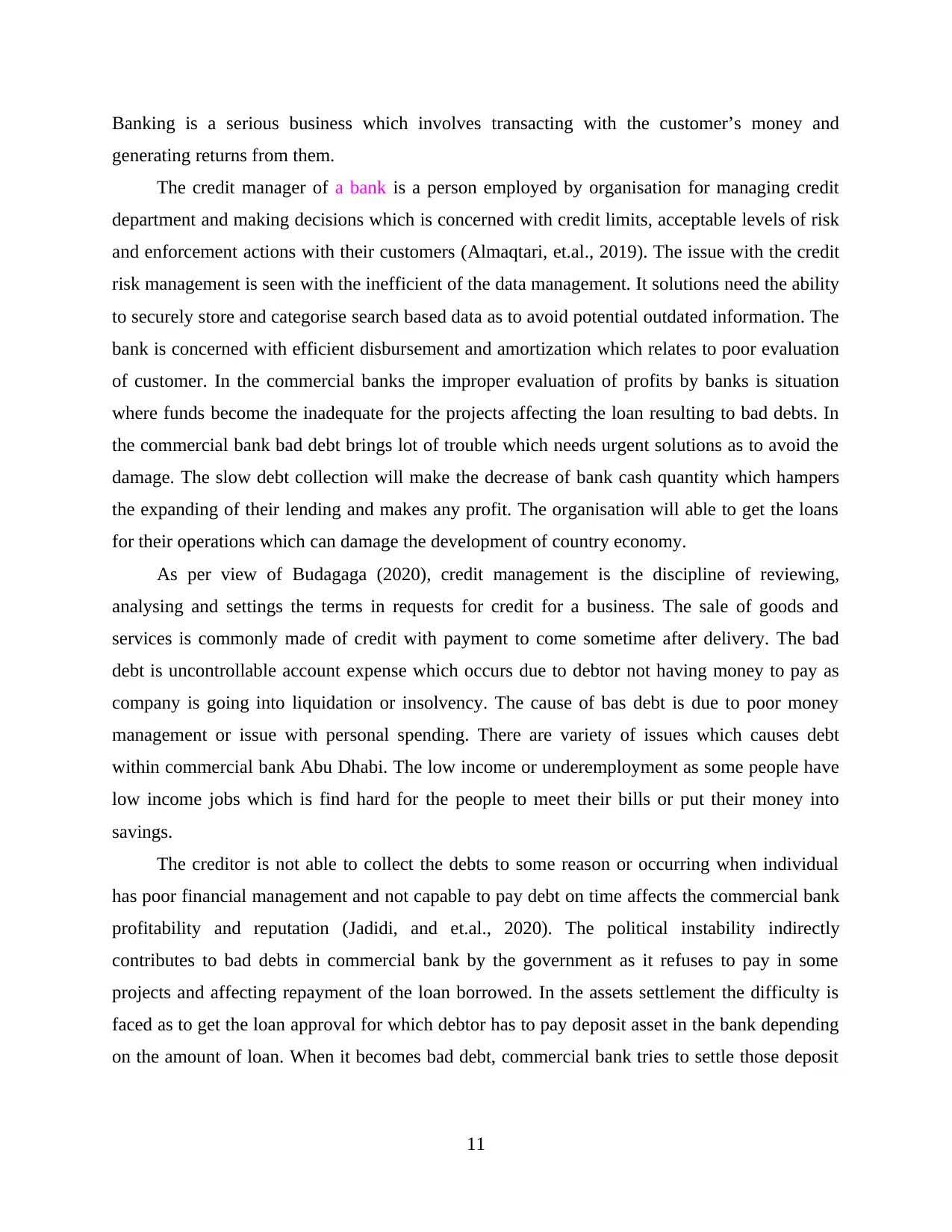
Banking is a serious business which involves transacting with the customer’s money and
generating returns from them.
The credit manager of a bank is a person employed by organisation for managing credit
department and making decisions which is concerned with credit limits, acceptable levels of risk
and enforcement actions with their customers (Almaqtari, et.al., 2019). The issue with the credit
risk management is seen with the inefficient of the data management. It solutions need the ability
to securely store and categorise search based data as to avoid potential outdated information. The
bank is concerned with efficient disbursement and amortization which relates to poor evaluation
of customer. In the commercial banks the improper evaluation of profits by banks is situation
where funds become the inadequate for the projects affecting the loan resulting to bad debts. In
the commercial bank bad debt brings lot of trouble which needs urgent solutions as to avoid the
damage. The slow debt collection will make the decrease of bank cash quantity which hampers
the expanding of their lending and makes any profit. The organisation will able to get the loans
for their operations which can damage the development of country economy.
As per view of Budagaga (2020), credit management is the discipline of reviewing,
analysing and settings the terms in requests for credit for a business. The sale of goods and
services is commonly made of credit with payment to come sometime after delivery. The bad
debt is uncontrollable account expense which occurs due to debtor not having money to pay as
company is going into liquidation or insolvency. The cause of bas debt is due to poor money
management or issue with personal spending. There are variety of issues which causes debt
within commercial bank Abu Dhabi. The low income or underemployment as some people have
low income jobs which is find hard for the people to meet their bills or put their money into
savings.
The creditor is not able to collect the debts to some reason or occurring when individual
has poor financial management and not capable to pay debt on time affects the commercial bank
profitability and reputation (Jadidi, and et.al., 2020). The political instability indirectly
contributes to bad debts in commercial bank by the government as it refuses to pay in some
projects and affecting repayment of the loan borrowed. In the assets settlement the difficulty is
faced as to get the loan approval for which debtor has to pay deposit asset in the bank depending
on the amount of loan. When it becomes bad debt, commercial bank tries to settle those deposit
11
generating returns from them.
The credit manager of a bank is a person employed by organisation for managing credit
department and making decisions which is concerned with credit limits, acceptable levels of risk
and enforcement actions with their customers (Almaqtari, et.al., 2019). The issue with the credit
risk management is seen with the inefficient of the data management. It solutions need the ability
to securely store and categorise search based data as to avoid potential outdated information. The
bank is concerned with efficient disbursement and amortization which relates to poor evaluation
of customer. In the commercial banks the improper evaluation of profits by banks is situation
where funds become the inadequate for the projects affecting the loan resulting to bad debts. In
the commercial bank bad debt brings lot of trouble which needs urgent solutions as to avoid the
damage. The slow debt collection will make the decrease of bank cash quantity which hampers
the expanding of their lending and makes any profit. The organisation will able to get the loans
for their operations which can damage the development of country economy.
As per view of Budagaga (2020), credit management is the discipline of reviewing,
analysing and settings the terms in requests for credit for a business. The sale of goods and
services is commonly made of credit with payment to come sometime after delivery. The bad
debt is uncontrollable account expense which occurs due to debtor not having money to pay as
company is going into liquidation or insolvency. The cause of bas debt is due to poor money
management or issue with personal spending. There are variety of issues which causes debt
within commercial bank Abu Dhabi. The low income or underemployment as some people have
low income jobs which is find hard for the people to meet their bills or put their money into
savings.
The creditor is not able to collect the debts to some reason or occurring when individual
has poor financial management and not capable to pay debt on time affects the commercial bank
profitability and reputation (Jadidi, and et.al., 2020). The political instability indirectly
contributes to bad debts in commercial bank by the government as it refuses to pay in some
projects and affecting repayment of the loan borrowed. In the assets settlement the difficulty is
faced as to get the loan approval for which debtor has to pay deposit asset in the bank depending
on the amount of loan. When it becomes bad debt, commercial bank tries to settle those deposit
11
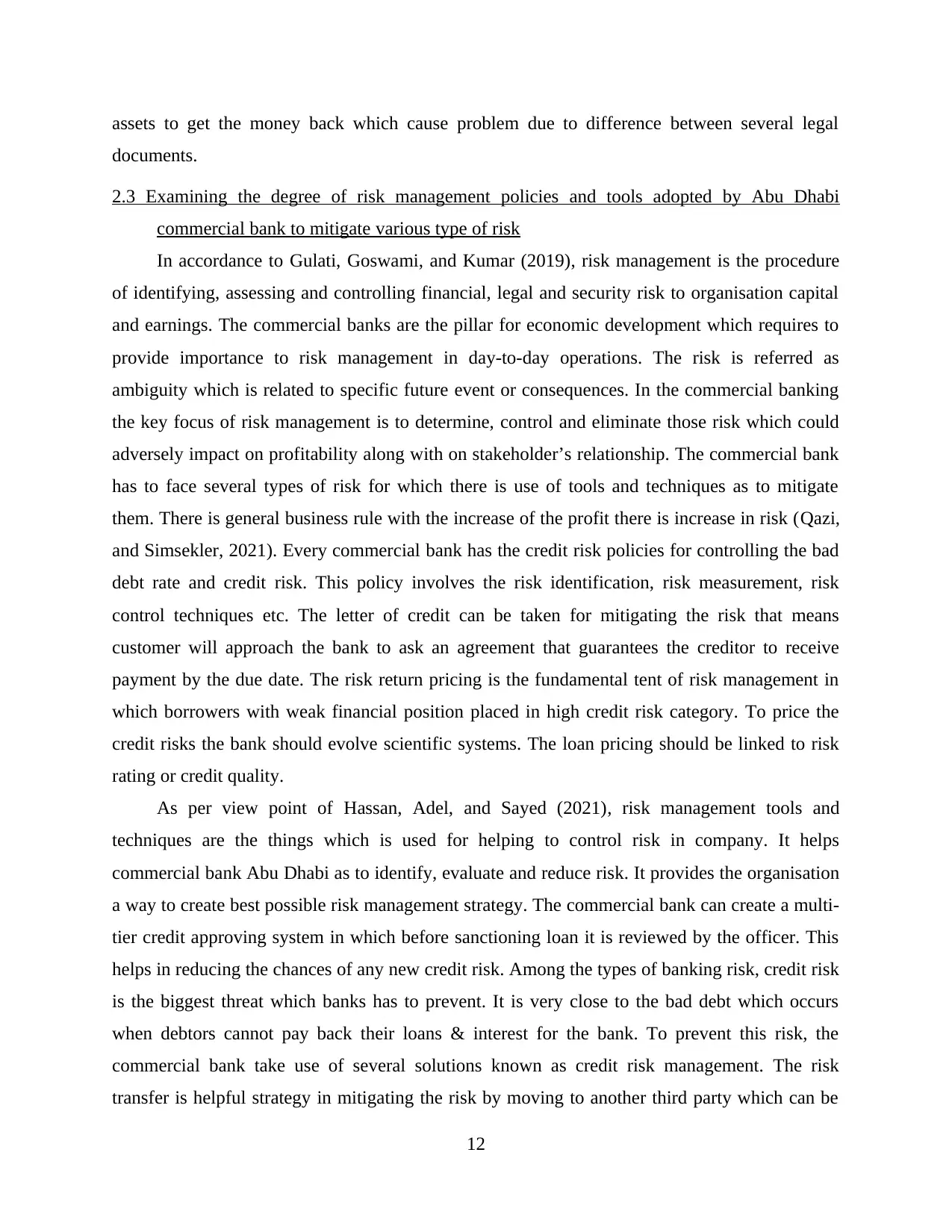
assets to get the money back which cause problem due to difference between several legal
documents.
2.3 Examining the degree of risk management policies and tools adopted by Abu Dhabi
commercial bank to mitigate various type of risk
In accordance to Gulati, Goswami, and Kumar (2019), risk management is the procedure
of identifying, assessing and controlling financial, legal and security risk to organisation capital
and earnings. The commercial banks are the pillar for economic development which requires to
provide importance to risk management in day-to-day operations. The risk is referred as
ambiguity which is related to specific future event or consequences. In the commercial banking
the key focus of risk management is to determine, control and eliminate those risk which could
adversely impact on profitability along with on stakeholder’s relationship. The commercial bank
has to face several types of risk for which there is use of tools and techniques as to mitigate
them. There is general business rule with the increase of the profit there is increase in risk (Qazi,
and Simsekler, 2021). Every commercial bank has the credit risk policies for controlling the bad
debt rate and credit risk. This policy involves the risk identification, risk measurement, risk
control techniques etc. The letter of credit can be taken for mitigating the risk that means
customer will approach the bank to ask an agreement that guarantees the creditor to receive
payment by the due date. The risk return pricing is the fundamental tent of risk management in
which borrowers with weak financial position placed in high credit risk category. To price the
credit risks the bank should evolve scientific systems. The loan pricing should be linked to risk
rating or credit quality.
As per view point of Hassan, Adel, and Sayed (2021), risk management tools and
techniques are the things which is used for helping to control risk in company. It helps
commercial bank Abu Dhabi as to identify, evaluate and reduce risk. It provides the organisation
a way to create best possible risk management strategy. The commercial bank can create a multi-
tier credit approving system in which before sanctioning loan it is reviewed by the officer. This
helps in reducing the chances of any new credit risk. Among the types of banking risk, credit risk
is the biggest threat which banks has to prevent. It is very close to the bad debt which occurs
when debtors cannot pay back their loans & interest for the bank. To prevent this risk, the
commercial bank take use of several solutions known as credit risk management. The risk
transfer is helpful strategy in mitigating the risk by moving to another third party which can be
12
documents.
2.3 Examining the degree of risk management policies and tools adopted by Abu Dhabi
commercial bank to mitigate various type of risk
In accordance to Gulati, Goswami, and Kumar (2019), risk management is the procedure
of identifying, assessing and controlling financial, legal and security risk to organisation capital
and earnings. The commercial banks are the pillar for economic development which requires to
provide importance to risk management in day-to-day operations. The risk is referred as
ambiguity which is related to specific future event or consequences. In the commercial banking
the key focus of risk management is to determine, control and eliminate those risk which could
adversely impact on profitability along with on stakeholder’s relationship. The commercial bank
has to face several types of risk for which there is use of tools and techniques as to mitigate
them. There is general business rule with the increase of the profit there is increase in risk (Qazi,
and Simsekler, 2021). Every commercial bank has the credit risk policies for controlling the bad
debt rate and credit risk. This policy involves the risk identification, risk measurement, risk
control techniques etc. The letter of credit can be taken for mitigating the risk that means
customer will approach the bank to ask an agreement that guarantees the creditor to receive
payment by the due date. The risk return pricing is the fundamental tent of risk management in
which borrowers with weak financial position placed in high credit risk category. To price the
credit risks the bank should evolve scientific systems. The loan pricing should be linked to risk
rating or credit quality.
As per view point of Hassan, Adel, and Sayed (2021), risk management tools and
techniques are the things which is used for helping to control risk in company. It helps
commercial bank Abu Dhabi as to identify, evaluate and reduce risk. It provides the organisation
a way to create best possible risk management strategy. The commercial bank can create a multi-
tier credit approving system in which before sanctioning loan it is reviewed by the officer. This
helps in reducing the chances of any new credit risk. Among the types of banking risk, credit risk
is the biggest threat which banks has to prevent. It is very close to the bad debt which occurs
when debtors cannot pay back their loans & interest for the bank. To prevent this risk, the
commercial bank take use of several solutions known as credit risk management. The risk
transfer is helpful strategy in mitigating the risk by moving to another third party which can be
12
⊘ This is a preview!⊘
Do you want full access?
Subscribe today to unlock all pages.

Trusted by 1+ million students worldwide
1 out of 27
Related Documents
Your All-in-One AI-Powered Toolkit for Academic Success.
+13062052269
info@desklib.com
Available 24*7 on WhatsApp / Email
![[object Object]](/_next/static/media/star-bottom.7253800d.svg)
Unlock your academic potential
Copyright © 2020–2025 A2Z Services. All Rights Reserved. Developed and managed by ZUCOL.





